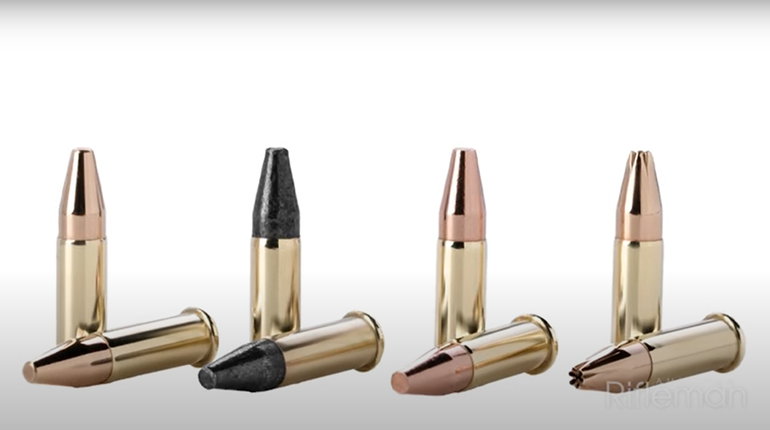
Hunting bullets have come a long way since the first round lead ball was launched game-ward from a long-barreled muzzleloader. Bullets now are long and streamlined, tipped with space-age material, and constructed of copper married to lead through special bonding processes. They are incredibly accurate, highly aerodynamic, and boast superb terminal performance. They are the finest killing projectiles the world has ever known; that’s a great thing for us as hunters.

What Kills Game?
To effectively and cleanly kill a big-game animal, a bullet needs to expand reliably and penetrate deeply no matter what it encounters en route. That’s the crux of bullet performance. If a bullet fragments to bits upon impact, or stops upon encountering bone, it likely won’t penetrate deeply enough to accomplish a clean kill. Or if it fails to expand, it may simply pencil through, doing minimal damage along the way and failing to accomplish a clean kill. Here’s a short anatomy-of-a-kill lesson for you:
There are three ways a bullet will cause rapid and mostly painless death:
1: Collapse the lungs, causing a dearth of oxygen to the brain.
2: Cause massive damage to the circulatory system including the heart, arteries, and veins, leading to catastrophic loss of blood and blood pressure.
3: Disrupt or destroy the central nervous system, which consists of the brain and spinal column.*
Of the three, number one—the lungs—offers the biggest target, results in the fastest death, and usually comes with the side benefit of accomplishing number 2 en-route. When a bullet passes through the lungs they collapse almost instantly. Arteries and veins, and sometimes the heart, are destroyed as well. Within seconds the brain is starved of oxygen and blood pressure plummets. The animal literally blacks out and tips over, unconscious even before it is dead. This is the ideal, painless-as-possible death that we as ethical hunters should strive for every time we take a shot.

Small, Medium or Large?
Choosing a hunting bullet is not a one-size-fits-all proposition. But since we’re discussing all-around loads for hunting big game, we will focus on cartridges and bullets that are suitable for everything from coyotes to moose. In my opinion, these start on the bottom end with the 6.5 calibers and work up to .375.
Many modern shooters and hunters opine that a small, accurate bullet is better than a big, hard-hitting bullet, because it’s more likely to be placed correctly into the vitals. There is some truth to this philosophy, but it’s also flawed because a large, accurate bullet will always, thanks to physics, hit harder and kill faster than a small one.
Bottom line, when hunting the bigger stuff like elk or moose, use the biggest caliber you can shoot comfortably and accurately.

Bullet Design
The way a projectile is built affects performance; both during flight and during impact. Let’s go over some of the basic design elements that make a difference:
Tip: There are two main tip designs used on hunting bullets: lead and polymer. A lead-tipped bullet will expand very reliably, but the tip will not be as aerodynamic as a polymer tip. It can also deform easily in the magazine, which will cost it accuracy and velocity at extended ranges.
A polymer tip is more aerodynamic and will resist deforming much better than lead. Polymer tips also initiate expansion very reliably. The only downside to polymer is that if shot at very high velocity and long distances, it will heat (from friction with the air) and begin to deform or degrade. This leads to a change in BC—not desirable when shooting far. Several manufacturers have solved this issue with proprietary tips that resist heat deformation.
Boat Tail: In simply terms, a boat tail will make a bullet much more aerodynamic than any flat-based bullet. If you never plan to shoot beyond 300 yards, don’t worry about it. But if you plan to shoot far, use a boat tail bullet.
Bonding and Locking Rings: Bullet designers have always struggled to keep a bullet’s copper jacket and lead core together during impact. One good solution is to use a locking ring inside the jacket that will help hold the core in place. Locking rings work, but not all the time.
A second, better solution is to use a chemical or molecular process to bond the core to the jacket. Bonded bullets always stay married, however the process of bonding can potentially compromise accuracy. That said, there are some truly accurate bonded bullets on the market.
Solid Copper: These bullets don’t feature any lead at all, being constructed from solid copper (or copper alloy). They have become a great option for today’s hunters, especially in states where lead projectiles are not legal for hunting. Since copper is not as heavy as lead these bullets necessarily cannot be as heavy as same-size conventional bullets, which compromises their long-range aerodynamics. They also don’t expand well at low velocity. However, all-copper bullets are legendary for accuracy and penetration. Choose them anytime you don’t plan to shoot extreme long range, and do want superior penetration.

The Perfect Bullet
Recent years have seen a tremendous spike in bullet engineering and design. Bullets are superbly accurate, aerodynamic and consistent. Shooters and hunters are now able to shoot farther than ever before with astonishing precision.
Even after all these advancements, the fact remains: a bullet needs to penetrate deeply and expand consistently to produce reliable, clean kills. But today’s shooters have added a real complication: a bullet needs to reliably perform those tasks at any and all shot distances. Short range with maximum velocity to long range and low velocity, that bullet still needs to expand and penetrate. And that, my friends, is an engineer’s worst nightmare. However, by hard work and savvy engineering, several have accomplished it. Lets take a look at some of the best all-around bullets on the market:

Best Bullets for Big Game
Federal Premium Terminal Ascent: This bullet features a proprietary “Slipstream” tip that will not erode or deform during flight, ensuring a consistent downrange ballistic coefficient. It’s held to match-grade standards during production, resulting in an exceptionally accurate and consistent bullet. And it’s designed for optimal aerodynamics—ideal for long range shooting and hunting.
The front half of the projectile is sort of a cup-and-core design, with the lead core bonded to the jacket. This part expands dramatically but consistently upon impact, even at very high and very low velocities.
The rearward portion of the bullet is solid copper and will hold its shape through hide, bone, and gristle, penetrating deeply and lethally. This is one of my very favorite bullets. It’s available in many popular cartridges including 6.5 PRC, .280 Ackley Improved, 7mm Remington Magnum, .30-06 Springfield, .300 Winchester Magnum, and more. It’s also available in component form for handloaders.
If you must shoot a very light caliber (6.5) for the big stuff, this is one of the very best bullets for the job.

Hornady ELD-X Precision Hunter: This bullet also sports a non-eroding proprietary “Heat-Shield” tip, ensuring consistent downrange ballistics. Projectiles are held to match-grade accuracy standards during production, and possess a well-deserved reputation for truly good accuracy. Designed to expand at any range, the jacket tapers dramatically, with the lead core held in place via a locking ring inside the jacket. At very-close range (high velocity) these bullets tend to separate, and if they don’t exit you’ll often find the jacket and core resting side by side under the skin on the far side of the animal. Some hunters might consider that a failure, but every animal I’ve seen shot with the ELD-X has been made very dead, very fast. It’s available in component form or loaded in Hornady’s Precision Hunter ammo line in almost every popular hunting cartridge.
Barnes LRX VOR-TX Long Range: Several years ago, I partnered with Book Your Hunt and conducted a survey to determine the bullet most favored by north-country outfitters and guides. These are the folks who live among and hunt the big stuff like grizzly bears and moose. Barnes bullets won hands down.
Barnes bullets are solid copper, and legendary for their ability to penetrate. Some of the older models (those without a polymer tip) have experienced the occasional failure to expand on light-skinned game, so I recommend sticking with tipped versions. And, since I like aerodynamic bullets, my favorites are the LRX (Long Range X) models. They sport the highest ballistic coefficient of all the Barnes projectiles, a good polymer tip, and a reputation for superb accuracy.
Since these bullets are solid copper they won’t expand at long range and low velocities as well as a “soft” bullet. However, inside recommended distances they expand perfectly, retain almost 100 percent of their weight, and penetrate like your mother-in-law’s stare. They’re available in component form in most calibers and loaded in Barnes VOR-TX Long Range ammunition.
This bullet is another favorite when you must hunt big animals with little calibers.

Nosler Accubond: This bullet has been around longer than the others on my list, and has a well-deserved reputation as an accurate, aerodynamic, deadly projectile. Featuring a polymer tip and a tapered jacket that’s bonded to the lead core, this bullet is built right. Born before the long-range shooting movement, it nonetheless has a decent ballistic coefficient and will expand at a wide range of velocities.
Nosler introduced the updated ABLR (Accubond Long Range) bullet in response to modern shooter’s demand for high-BC projectiles. These bullets feature similar bonded construction design but are a bit more finicky than original Accubonds. However, if your rifle likes them they offer terminal performance as good as the originals, with superior aerodynamics. They’re available in component form in most popular calibers, and you can buy loaded ammo from Nosler, Winchester, Black Hills, and more.

More Good Stuff
There are, of course, other great bullets on the market today. I don’t have space to cover them in detail, but I’d be remiss if I didn’t mention them at all. So here you go:
Remington Core Lokt (I hear this venerable bullet is getting a new polymer tip. Excited to see how that develops).
Sierra Tipped Game King. A softer bullet, better for expansion than penetration, superbly accurate.
Winchester Copper Impact. New on the scene, this solid copper projectile should prove to be an awesome hunting bullet for traditional-to-moderate ranges.
Berger Hybred. Favored by long-range hunters, these are known for superb accuracy and aerodynamics and explosive terminal performance. Not great at penetrating when they’re going really fast or when they hit big bone, so choose your shots wisely.
Hornady CX. Another great solid copper bullet, this is the updated and improved version of Hornady’s well-known GMX projectile.
Nosler Partition. It hurt my feelings to not highlight the Partition in the main section of this article, because it’s such a historic, deep-penetrating, explosive-expansion bullet. At traditional hunting ranges, it is superb.

Conclusion
When you’re choosing a hunting bullet pick several options that are well suited to the game at hand. Then test them for accuracy and consistency. Let your rifle decide which one it prefers, and feed that load into your magazine when you head into the field.
*Author’s Note: Shooting a big game animal in the brain or spine is hard to do, since the target is small and often moving. If you miss, you may hit the animal someplace that will result in a long, agonizing death such as the jawbone, throat or sinus cavity. An animal hit like that will run away and die but you’ll never recover it, so in most circumstances brain or neck/spine shots should be avoided.





































